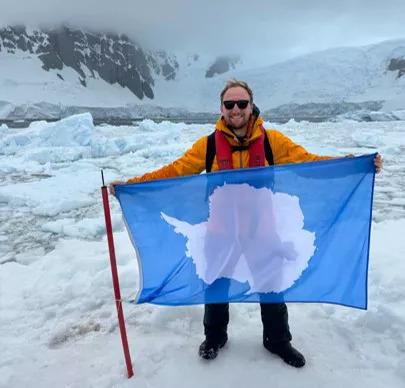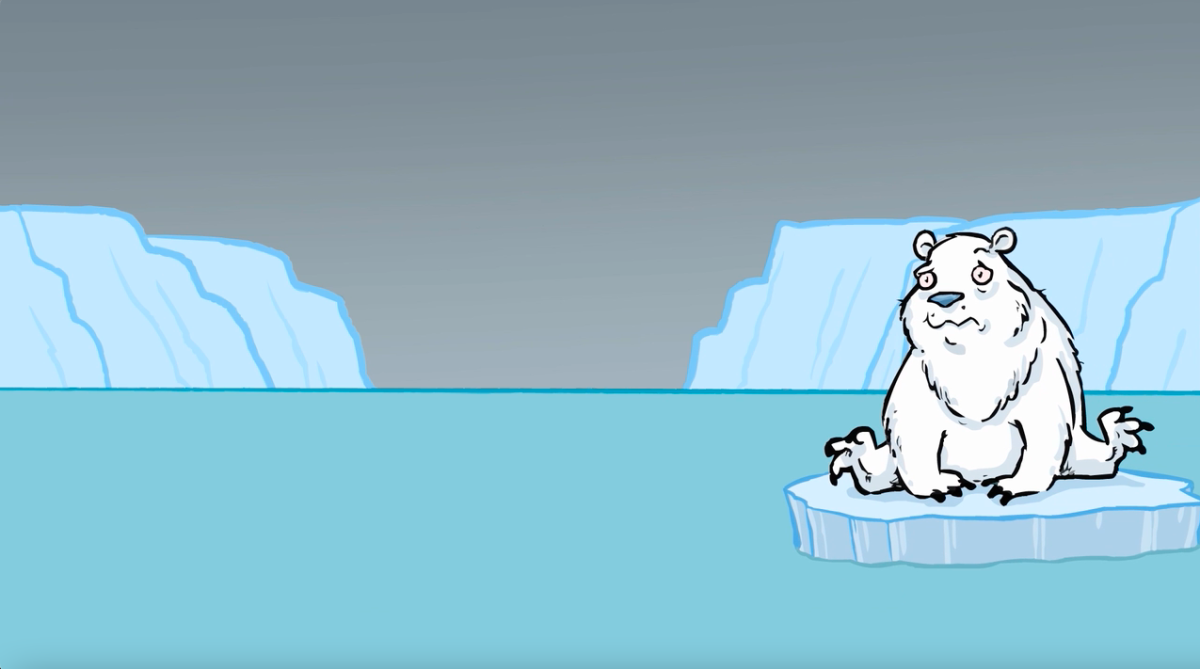Connecting the Blue Economy to the Arctic and Antarctic Oceans
The blue economy from pole to pole
By Josh Hasdell Senior Manager KPMG in Canada
I recently had the privilege of visiting the Antarctic when I joined an expedition group with other curious folks from all over the world alongside a team of glaciologists and marine biologists. As a scuba diver and marine biologist myself, I felt excited about the voyage. As a corporate professional focused on ESG, nature and decarbonization services, as well as the blue economy, I looked forward to gathering first-hand information that would help drive and contextualize this work.
The expedition team I was with visits the region regularly, evaluating the snow and ice and their physical properties. They observe, analyze, measure, compare, and report back. Us regular folks visited the southern continent this one time, (or, at least the first time) to ooh and aah. The sheer size of glaciers and ice shelves astonished us. Our jaws dropped at the substantial number and sizes of whales and marine mammals that live there, along with the icebergs and glaciers. And watching penguins behave in their natural habitat thrilled us all.
Granted, the north and south poles are far, far away. Few of us interact with them the way we do our own homeland’s coasts and shorelines and the hundreds more abroad that we access as tourists, workers, researchers, and consumers. When so remote, so too might our awareness and consideration become of them and their role in the blue economy, particularly when we more regularly contend with urban smog, smoke from wildfires, and extreme weather.
But the poles are just as involved in the blue economy as the oceans we work and play in. As we observe the United Nations’ World Oceans Day 2024, we pay special attention to polar waters, their global roles and transformations, emerging opportunities they present, and our connection to them as businesspeople.
The blue economy from pole to pole
The World Bank has defined the blue economy as the “sustainable use of ocean resources for economic growth, improved livelihoods and jobs, and ocean ecosystem health”.1 The concept emphasizes the importance of conserving ocean ecosystems while harnessing their potential for economic growth and development. Its key principles include sustainability, equity, and social inclusiveness, aiming to make sure that ocean resources get utilized in a way that benefits both present and future generations.
The blue economy encompasses a wide range of sectors such as maritime transport and shipping; fisheries and aquaculture, marine conservation and environmental protection; offshore oil and gas exploration and production, but also tourism and recreation, marine biotechnology and pharmaceuticals; marine insurance and risk, digital data and telecommunications, and even marine-based textiles and materials. These commercial pursuits might not all leap to mind when one thinks of polar waters since the Arctic and Antarctic are typically associated with glaciers, icebergs and freezing waters. But climate change is changing that profile.
Vital and vulnerable
Just like weather patterns and events, the oceans are also transforming. We are witnessing changing ocean chemistry – alterations in the chemical composition of oceans, primarily driven by human activities such as the burning of fossil fuels and deforestation. The two main aspects of this change are ocean acidification (decreased pH levels) and ocean deoxygenation (when warmer surface temperatures and changes in ocean circulation patterns reduce the solubility of oxygen in seawater). These aspects threaten marine biodiversity, ecosystem functioning, and the amenities oceans provide such as food security, climate regulation, and carbon sequestration.
In the north and south poles, additional ocean factors are at play.
Ocean warming driven by climate change is a primary driver of ice melt. In Antarctica, warmer ocean water can undercut the base of an ice shelf, causing it to destabilize and calve (that is, shed massive chunks of ice). The collapse or release of an ice shelf can lead to more rapid discharge of continental ice, which contributes to increased sea level posing dangers related to flooding, coastal erosion, saltwater intrusion that contaminates drinking supplies, and loss of coastal ecosystems. Because they are in contact with the atmosphere above and the ocean below, ice shelves are the most vulnerable component of the Antarctic cryosphere to environmental change.2
In parallel, the Arctic had its warmest summer on record last year, continuing a 17-year trend of consistent sea ice melting.
Opportunities and challenges
While melting ice poses complex challenges related to environmental sustainability, resource management, and community resilience, it can also unlock new and unexpected economic opportunities.
The Arctic
As ice gives way, new trade routes can offer shorter transit times between Asia, Europe, and North America. Some studies suggest that transit times between Asia and Atlantic ports could decrease by 30% to 50%, reducing travel by 14 to 20 days.
The Northern Sea Route is the shortest shipping route between the western part of Eurasia and the Asia-Pacific region. It is currently navigable for just a few months of the year with support from Russian icebreakers. However, melting ice is expected to gradually expand the route out into international waters, with predictions of ice-free Arctic summers as early as 2035.3 Shipping companies already use moderately ice-strengthened vessels which can operate earlier during the summer and later into the fall.4
The Northwest Passage runs between the Atlantic and Pacific oceans through the Arctic Ocean, along the northern coast of North America via waterways through the Arctic Archipelago of Canada. As more ice melts, the Northwest Passage through northern Canada could become a viable competitor to the Northern Sea Route, and a seasonal direct route across the North Pole might emerge in the longer term if the ice cap disappears entirely during parts of the year.5
These new sea lanes can bring significant cost savings to shipping companies, boost maritime trade and stimulate economic activity in the region. In fact, the number of unique ships entering the Arctic Polar Code area6 from 2013 to 2023 increased by 37%, around 500 ships . Fishing vessels and general cargo ships7 represent the majority of this increased traffic.
As Arctic shipping increases so too does the need to collect data and monitor trends. PAME—the Protection of the Arctic Marine Environment—developed the ASTD—Arctic Ship Traffic Data—a project that “collects and distributes accurate, reliable and up-to-date information on shipping activities in the Arctic”.8 At the same time, Russia has activated the world’s first Arctic observation satellite system, which aims to provide continuous meteorological and environmental monitoring of the Arctic surface, including the Northern Sea Route, which runs near the Siberian coastline. As more satellites get added (up to eight), the system expects to forecast the viability of Arctic shipping routes, enhance Arctic telecommunications services for air traffic and commercial shipping, and explore hydrocarbon exploration.9
Vast oil and gas reserves previously trapped beneath the ice, including an estimated 30% of the world’s undiscovered natural gas and 13% of its undiscovered oil, as well as critical minerals needed for the energy transition away from fossil fuels are becoming more feasible and economical to access leading to increased interest in offshore drilling, mining, and exploration by energy companies. Regional infrastructure along the Canadian and US coastlines will be required in combination with collaboration over EEZs (exclusive economic zones) and overlapping national claims to the seabed and its resources.10 Russia is keen to expand its Arctic LNG production here, with plans for extraction and transportation drawn up. Associated environmental risks for all energy and natural resources opportunities such as oil spills and habitat destruction must be considered and properly mitigated.
As cruise tourism, wildlife watching, and adventure tourism become more accessible, local communities can enjoy economic benefits through increased tourism spending, job creation, and infrastructure development. Its environmental impact, however, will require sustainable management practices to minimize negative effects on fragile Arctic ecosystems.
Retreating sea ice presents new areas for fishing, particularly for species such as Arctic cod and shrimp. Commercial fishing operations can expand into previously inaccessible waters, potentially increasing yields and revenue for fishing communities.
New subsea data cable routes between Europe and Asia can get introduced to address growing internet traffic. Correspondingly, two projects have emerged.
(1) Far North Fiber is a joint development project aimed to deliver the first long-haul submarine fibre optic system through the Northwest Passage to connect Asia to Europe, with funding from the EU’s Connecting Europe Facility – Digital program.
(2) Polar-Connect, a Northern European initiative aimed to obtain secure and resilient connectivity through the Arctic to Asia and North America, plans to route cables under the ice cap of the North Pole. The installation of these projects could improve connectivity for underdeveloped parts of the region currently facing unreliable internet access, create necessary digital redundancy, and benefit the scientific community specifically with respect to climate research, marine biology, oceanography, seismology, and more.11
Expect to see more than $1 trillion spent on infrastructure investments as a growing list of international stakeholders look to capitalize on the blue economy of the high north.12
The Antarctic
Likewise, melting ice in the Antarctic can have multifaceted impacts on the blue economy. Since increased ice melt and the release of icebergs into the ocean can pose hazards to navigation, enhanced safety measures and navigation assistance for vessels operating in polar waters become necessary. Additionally, changes in ice conditions may impact the operation of research vessels, supply ships, and support vessels servicing scientific research stations and field camps in the Antarctic.
Altered oceanographic conditions and marine ecosystems affect the distribution and abundance of fish stocks and krill – key components of the Antarctic and global food web. Changes in sea ice extent and duration can impact the breeding, feeding, and migration patterns of fish species, potentially affecting commercial fisheries.
Declining sea ice extent and changes in ice conditions can affect access to wildlife habitats and scenic landscapes. These alterations will likely influence the itinerary and experiences offered by tour operators. Additionally, changes in ocean temperatures and ice melt can affect the abundance and distribution of marine wildlife, impacting selection of tourism destinations and wildlife viewing opportunities.
The scientific research and monitoring of climate change impacts, oceanographic processes, and ecosystem dynamics in the region that I witnessed on the Antarctic expedition can expand as researchers study the effects of ice melt on sea level rise, ocean circulation, marine biodiversity, and ecosystem functioning, providing valuable insights into the drivers and consequences of environmental change in the Antarctic. This important research informs policy decisions, resource management strategies, and conservation efforts aimed at preserving the health and resilience of Antarctic marine ecosystems and the blue economy.
Harnessing transformation through collaboration
The Arctic and the Antarctic regions are transforming rapidly. Their inevitably changing profiles underscore climate change effects and influence decision-making, and have sparked geopolitical conversation and debates. The number of global stakeholders and spirit of competition has swelled as these opening regions force contemplation of land and coastlines ownership and/or stewardship, and international security.
At the same time, the regions have uncovered important prospects for the global economy. More efficient trade routes, greater scientific research and development, enhanced data and telecommunications, and increased renewable energy investments all present undeniably valuable benefits for global growth, development, and interconnectedness. Businesses around the world need to understand how the blue economy, including the north and south poles, impacts their day-to-day commerce in-house, as well as externally as they interact with their suppliers and customers.
Working together on a global scale by seeking and collecting trustworthy data, sharing knowledge, pooling resources, and distributing leading practices means that while we prioritize the long-term health and resilience of the Arctic and the Antarctic, we have novel occasions to realize value from and within the blue economy.
As our northernmost and southernmost regions continue to transform, perhaps a polar expedition is not so far away after all.
To view this article on kpmg.com, please click here.
Contact us
Senior Manager
KPMG in Canada
Connect with us
Footnotes
[1] https://www.worldbank.org/en/news/infographic/2017/06/06/blue-economy
[2] https://www.antarctica.gov.au/about-antarctica/weather-and-climate/climate-change/ice-shelves/
[3] https://www.nature.com/articles/s41558-020-0865-2
[4] https://www.thearcticinstitute.org/future-northern-sea-route-golden-waterway-niche/
[5] EG Global Macro Geopolitics_Melting Arctic ice heats up the geopolitical competition.pdf
[6] The International Code for Ships Operating in Polar waters as defined by the International Maritime organization: https://www.imo.org/en/OurWork/Safety/Pages/polar-code.aspx
[7] https://arctic-council.org/news/increase-in-arctic-shipping/#_ftn1
[8] https://pame.is/index.php/projects/arctic-marine-shipping/astd
[10] EG Global Macro Geopolitics_Melting Arctic ice heats up the geopolitical competition.pdf
[11] https://nordu.net/polar-connect/
[12] EG Global Macro Geopolitics_Melting Arctic ice heats up the geopolitical competition.pdf



